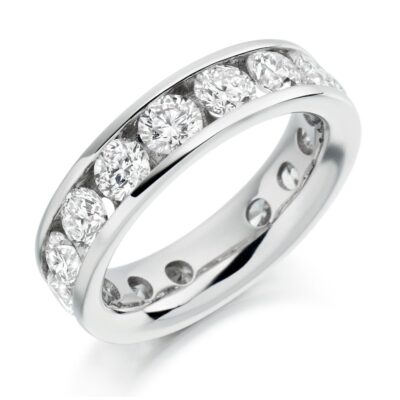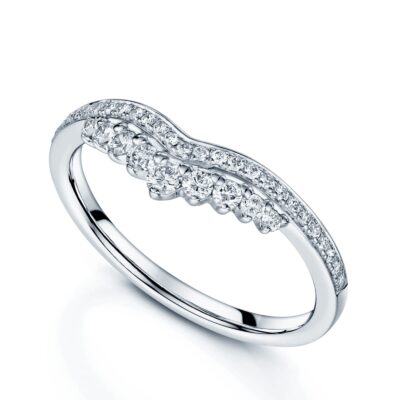Eternity rings come in many different styles, but they all have one thing in common — diamonds or other gemstones set either part-way or all the way round the band. These two options are referred to as half eternity and full eternity rings respectively. An eternity ring is traditionally presented as a gift to mark a major life event, such as the birth of a child or a wedding anniversary. Increasingly, we are also seeing women choosing to have diamond-set wedding rings, which are all intents and purposes of an eternity ring.

Half Eternity Or Full Eternity?
Most people assume that a full eternity ring is always preferable, and that the only reason to have a half eternity ring is cost. Of course it is true that it is more expensive to set diamonds all the way round a ring than part of the way round. However, if you’re undecided, there are a couple of other reasons that a half eternity ring might be the way to go.
Firstly, it is not always possible to resize a full eternity ring. Even if it can be resized it is inevitably difficult and therefore expensive as gems will need to be added or removed from the ring. Secondly, a full eternity ring is easier to damage than a half eternity ring, as the gems on the underside of the finger are more vulnerable to wear and tear. This is simply a result of the way we use our hands to pick things up and hold on to things, which brings these stones into regular contact with hard objects such as door handles. This isn’t to say that you shouldn’t choose a full eternity ring if that’s your preference, but you should be aware of the advantages to the half eternity before you make a decision.
Choosing The Right Width
Typically, the wider the ring is, the bigger the diamonds will be – and the more the ring will sparkle. However most people don’t want a ring that looks wide and clumsy on their finger (never mind the cost of using larger diamonds), so there is a trade-off when judging the correct width.
Choosing The Right Setting Style
The decision on width will also depend on your preferred setting style, as a given width may require different sized diamonds depending on the style of the setting work. The most traditional style is known as grain setting (each of the diamonds is held in place by tiny beads or grains of metal, with a thin edge or ‘thread’ creating a border around them). Sometimes the edge will be finished with mil-grain detail, which gives the ring a vintage feel.

Also popular is cut-down setting, sometimes known as edge setting. In this style, the diamonds cover the full width of the band, with the setter cutting out metal at the edges to secure the stones. This technique could be a good choice if you would like a really slim band, as it maximises the size of the diamonds that can be fitted into a ring of any given width – even a really thin band can give off significant sparkle. A channel setting provides a more contemporary feel. The diamonds are secured within a channel, the metal hiding the very top and bottom of each stone. Unlike the other setting styles, this technique can work well with princess or square diamonds. By contrast, a shared claw setting can work well with larger round diamonds, as it is accentuates the shape of the stones.
Coloured Gemstones
The vast majority of eternity rings are set with small diamonds, as most clients want a ring that sparkles as much as possible. Coloured stones can also look beautiful in a eternity ring and is becoming increasingly popular in stacking sets. Please do contact us for any further information or if you’d be interested in commissioning a bespoke eternity ring.